Kaus Media, also known as Delta Sagittarii, is an orange giant star located in the constellation of Sagittarius, the celestial archer. It is the fourth brightest star in its constellation and it is, in fact, a binary star.
Key Facts & Summary
- Kaus Media is an orange giant star of spectral type K3 III, located at around 348 light-years / 107 parsecs away from the Sun.
- Kaus Media has an apparent magnitude of +2.70 and an absolute magnitude of -1.99.
- Kaus Media is a binary star, consisting of the K class giant and a small white dwarf companion.
- The primary star, Kaus Media, has a mass of 3.21 times that of the sun.
- Kaus Media is considerably bigger than our sun, it has expanded up to 16 solar radii.
- Kaus Media is actually a weak barium star whose spectrum shows an overabundance of s-process elements, most likely as a result of mass transfer from the white dwarf.
- It is possible that Kaus Media’s expanded radius may be caused by the white dwarf companion since most K-type orange stars are much more stable.
- Kaus Media has a weak surface gravity of 0.30 cgs.
- The star is considerably cooler than our sun, with surface average temperatures estimated at around 4.203 K.
- Kaus Media is actually quite a young star, having an estimated age of 260 million years.
- Along with seven other stars, Kaus Media forms the Teapot asterism that dominates the constellation of Sagittarius.
- The Teapot asterism consists of Kaus Media/Delta Sagittarii, Zeta Sagittarii, Lambda Sagittarii, Sigma Sagittarii, Tau Sagittarii, and Phi Sagittarii.
- Along with its white dwarf companion, Kaus Media also has three very faint line-of-sight companions.
- The star has a radial velocity of around -19.9 kilometers / 12.3 miles per second
Kaus Media also had the name Kaus Meridionalis and Media. Many stars in the constellation of Sagittarius are in a sense wrongfully designated, since many people are used to stars being designated based on their brightness, however, this is not always the case.
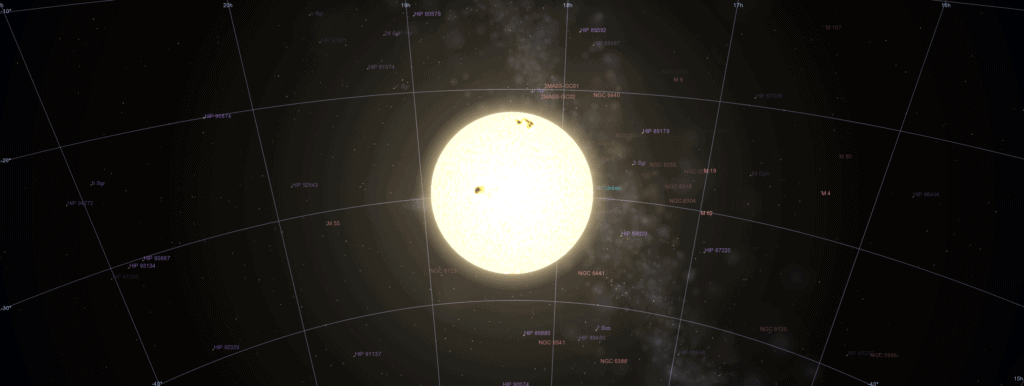
The name Kaus Media derives from the Arabic “qaws”, meaning “bow” and the Latin “media” meaning “middle,” The star was named as such since it mark’s the center of the celestial Archer’s bow. The brightest star of the constellation, Kaus Australis marks the southern tip of the bow while the fainter Kaus Borealis marks the northern tip.
Formation
It is unknown if Kaus Media is associated with any moving stellar group. However, the star is very young, much younger than our sun. It has been estimated that it has only 260 million years. The star most likely formed from a molecular cloud of gas and dust. Gravity pulled this swirling gas and dust together and formed one of the key stars of the Sagittarius constellation, Kaus Media.
Distance, Size, and Mass
Kaus Media is located at around 348 light-years / 107 parsecs away from the Sun. It is one of the brightest stars in the night sky, visible to the naked eye.
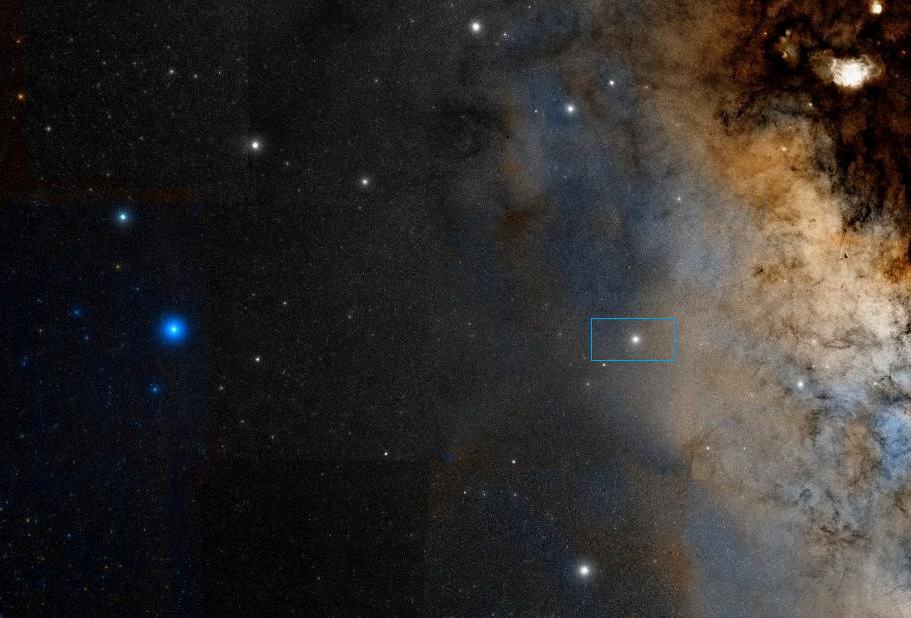
Kaus Media has around 3.21 solar masses or 321% of the sun’s mass. It is considerably bigger than our sun, it has expanded up to 16 solar radii or 1.600% the sun’s radius. Most likely, its mass and overall size can be attributed to its white dwarf companion since there is an active process of mass transfer between the stars.
Other Characteristics
Kaus Media is an orange giant star of spectral type K3 III, it has an apparent magnitude of +2.70 and an absolute magnitude of -1.99. The star has a radial velocity of around -19.9 kilometers / 12.3 miles per second and a weak surface gravity of 0.30 cgs.
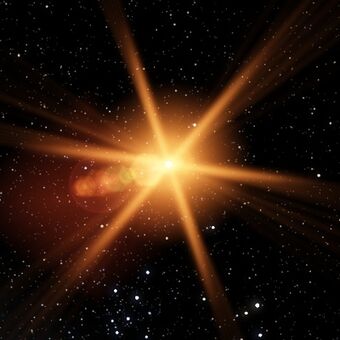
Kaus Media is considerably cooler than our sun, with surface average temperatures estimated at around 4.203 K. Kaus Media is a binary star, its companion star is a white dwarf with little known characteristics.
What is known is that the primary star is a weak barium star whose spectrum shows an overabundance of s-process elements, most likely as a result of mass transfer from the white dwarf.
Stellar System
The exact distance between Kaus Media and the white dwarf is currently unknown. It is clear though, that they are gravitationally bound to one another and are very close.
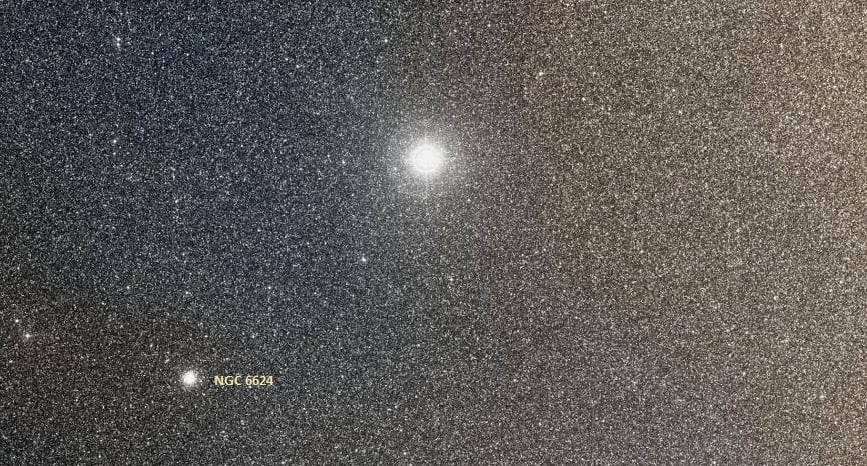
Besides its white dwarf companion, Kaus Media also has three very fain line-of-sight companions, they are not physically related. The closest one is a 14h magnitude star that appears to be 26 arcseconds away from Kaus Media. Another 15th magnitude star is separated by Kaus Media by a distance of 40 arcseconds. The third star, lies at 58 arcseconds.
Location
Kaus Media is located in the zodiacal constellation of Saggitarius, the celestial archer. This constellation is situated exactly towards the center of the Milky Way.
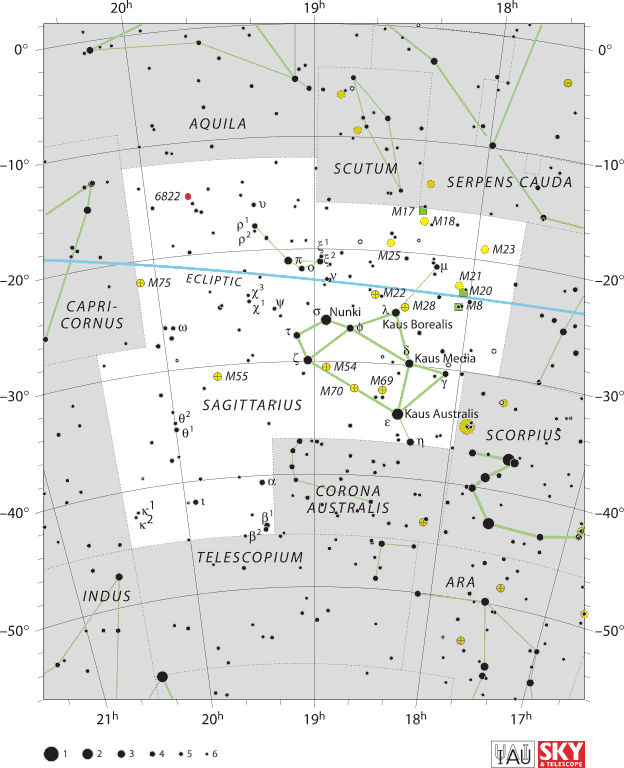
Together with the brightest star in the constellation, Kaus Australis and Kaus Borealis, Kaus Media marks the center of the celestial Archer’s bow.
The same stars together with Alnasl, Ascella, Nunki, Tau Sagittarii, and Phi Sagittarii form the Teapot asterism. This asterism is very bright and dominates the western half of Sagittarius. Kaus Media is one of the stars which forms the celestial Teapot’s body.
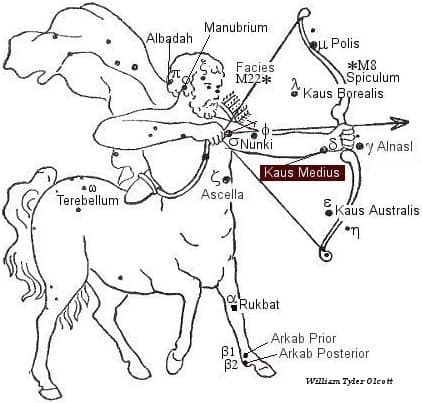
Since the constellation of Saggitarius lies in the direction of the Milky Way’s center, it is located in the densest region of the galaxy. There are many interesting stars and deep-sky objects in Saggitarius, such as globular clusters, Messier objects, nebulae, and much more.
The month of August is the best time to try and observe the celestial objects in Sagittarius. Most objects are not visible year-round to northern observers and even farther north, they are completely invisible. When it comes to the mid-northern latitudes, they can only be seen above the southern horizon during the summer months.
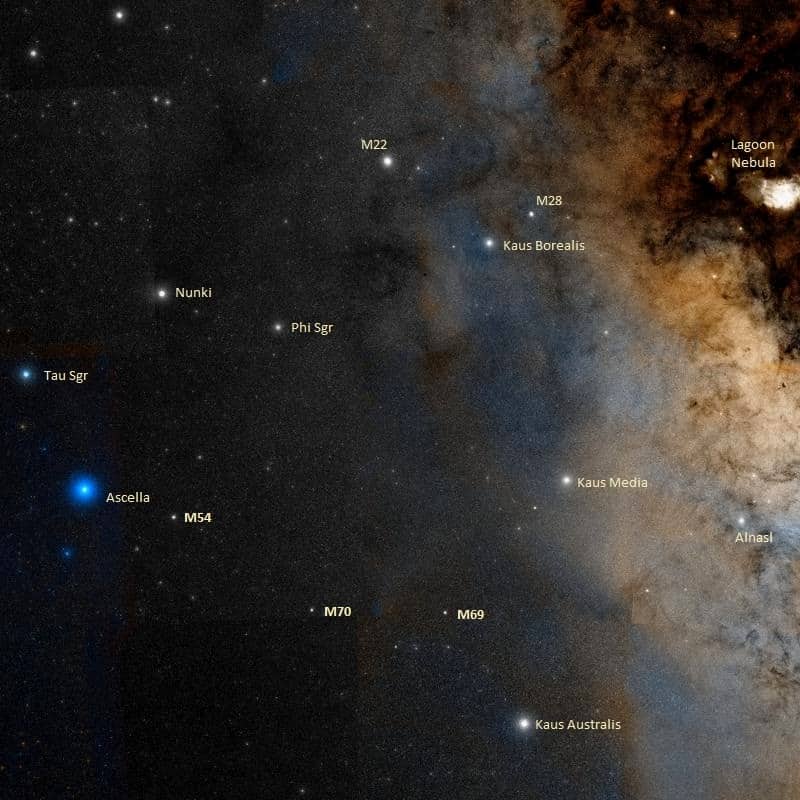
The Future
Since Kaus Media is an orange K-type star, it should remain stable for long periods of time. Such stars are usually favorable for exoplanets that might reside in their habitable zone. However, the presence of the white dwarf and its effects on Kaus Media might make the giant’s life much shorter. Observations continue in order to establish the negative effects of the white dwarf.
Did you know?
- The constellation of Sagittarius is one of the Greek constellations, first cataloged by the Greco-Roman astronomer Ptolemy, in the 2nd century C.E.
- Sagittarius is the 15th largest constellation in the sky and contains more Messier objects than any other constellation
- In a sense, Sagittarius contains the center of the Milky Way, marked by the radio source / supermassive black hole, designated as Sagittarius A*.
- Among the stars of the Teapot asterism, of which Kaus Media is also part of, only Kaus Australis and Nunki were included in the list of the 58 navigational stars. Only the brightest and the most easily recognizable stars are included in this group.
- The Egyptian astronomer Al Achsasi al Mouakket listed Kaus Media as “the second of Warida” in his 17th-century Calendarium.
- Warida is an asterism that consists of Kaus Australis, Kaus Media, Eta Sagitarrii, and Gamma Sagitarri. Warida translates to “the ostrich going down the water”, a representation of the two celestial groups of ostriches in Sagittarius, the other group is marked by Sigma, Phi, Zeta, Chi, and Tau Sagittarii. Kaus Australis and Polis represented the ostriches’ keepers
- Kaus Australis, Kaus Media, and Alnasl formed the ancient Akkadian asterism known as Sin-nun-tu, meaning shadow or the swallow.
- In Hindu astrology, Kaus Media was known as Purvashada Nakshatra.
- The Chinese knew the star as the Second Star of Winnowing Basket – an asterism formed by Kaus Australis, Gamma Sagittarii, and Eta Sagittarii – the asterism is one of the seven mansions of the Azure Dragon.
Sources:
Image source:
- https://upload.wikimedia.org/wikipedia/commons/3/3f/Kaus_Media_panorama.png
- https://www.star-facts.com/wp-content/uploads/2019/11/Kaus-Media.jpg?189db0&189db0
- https://vignette.wikia.nocookie.net/thexuniverse/images/4/4c/Kaus_Media.jpg/revision/latest/scale-to-width-down/340?cb=20120822215214
- https://www.star-facts.com/wp-content/uploads/2019/11/Kaus-Media-and-NGC-6624.jpg?189db0&189db0
- https://upload.wikimedia.org/wikipedia/commons/thumb/5/54/Sagittarius_IAU.svg/624px-Sagittarius_IAU.svg.png
- https://www.constellationsofwords.com/images/stars/KausMedius.JPG
- https://www.star-facts.com/wp-content/uploads/2019/09/Teapot.jpg?189db0&189db0
